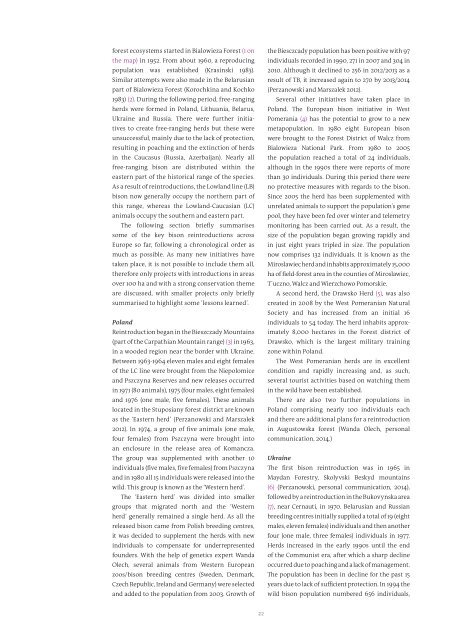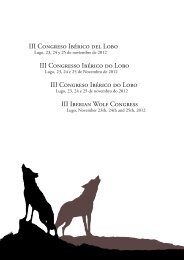Bison-Rewilding-Plan-2014
Bison-Rewilding-Plan-2014
Bison-Rewilding-Plan-2014
- No tags were found...
Create successful ePaper yourself
Turn your PDF publications into a flip-book with our unique Google optimized e-Paper software.
forest ecosystems started in Bialowieza Forest (1 onthe map) in 1952. From about 1960, a reproducingpopulation was established (Krasinski 1983).Similar attempts were also made in the Belarusianpart of Bialowieza Forest (Korochkina and Kochko1983) (2). During the following period, free-rangingherds were formed in Poland, Lithuania, Belarus,Ukraine and Russia. There were further initiativesto create free-ranging herds but these wereunsuccessful, mainly due to the lack of protection,resulting in poaching and the extinction of herdsin the Caucasus (Russia, Azerbaijan). Nearly allfree-ranging bison are distributed within theeastern part of the historical range of the species.As a result of reintroductions, the Lowland line (LB)bison now generally occupy the northern part ofthis range, whereas the Lowland-Caucasian (LC)animals occupy the southern and eastern part.The following section briefly summarisessome of the key bison reintroductions acrossEurope so far, following a chronological order asmuch as possible. As many new initiatives havetaken place, it is not possible to include them all,therefore only projects with introductions in areasover 100 ha and with a strong conservation themeare discussed, with smaller projects only brieflysummarised to highlight some ‘lessons learned’.PolandReintroduction began in the Bieszczady Mountains(part of the Carpathian Mountain range) (3) in 1963,in a wooded region near the border with Ukraine.Between 1963-1964 eleven males and eight femalesof the LC line were brought from the Niepolomiceand Pszczyna Reserves and new releases occurredin 1971 (80 animals), 1975 (four males, eight females)and 1976 (one male, five females). These animalslocated in the Stuposiany forest district are knownas the ‘Eastern herd’ (Perzanowski and Marszalek2012). In 1974, a group of five animals (one male,four females) from Pszczyna were brought intoan enclosure in the release area of Komancza.The group was supplemented with another 10individuals (five males, five females) from Pszczynaand in 1980 all 15 individuals were released into thewild. This group is known as the ‘Western herd’.The ‘Eastern herd’ was divided into smallergroups that migrated north and the ‘Westernherd’ generally remained a single herd. As all thereleased bison came from Polish breeding centres,it was decided to supplement the herds with newindividuals to compensate for underrepresentedfounders. With the help of genetics expert WandaOlech, several animals from Western Europeanzoos/bison breeding centres (Sweden, Denmark,Czech Republic, Ireland and Germany) were selectedand added to the population from 2003. Growth ofthe Biesczcady population has been positive with 97individuals recorded in 1990, 271 in 2007 and 304 in2010. Although it declined to 256 in 2012/2013 as aresult of TB, it increased again to 270 by 2013/<strong>2014</strong>(Perzanowski and Marszalek 2012).Several other initiatives have taken place inPoland. The European bison initiative in WestPomerania (4) has the potential to grow to a newmetapopulation. In 1980 eight European bisonwere brought to the Forest District of Walcz fromBialowieza National Park. From 1980 to 2005the population reached a total of 24 individuals,although in the 1990s there were reports of morethan 30 individuals. During this period there wereno protective measures with regards to the bison.Since 2005 the herd has been supplemented withunrelated animals to support the population’s genepool, they have been fed over winter and telemetrymonitoring has been carried out. As a result, thesize of the population began growing rapidly andin just eight years tripled in size. The populationnow comprises 132 individuals. It is known as theMiroslawiec herd and inhabits approximately 15,000ha of field-forest area in the counties of Miroslawiec,T`uczno, Walcz and Wierzchowo Pomorskie.A second herd, the Drawsko Herd (5), was alsocreated in 2008 by the West Pomeranian NaturalSociety and has increased from an initial 16individuals to 54 today. The herd inhabits approximately8,000 hectares in the Forest district ofDrawsko, which is the largest military trainingzone within Poland.The West Pomeranian herds are in excellentcondition and rapidly increasing and, as such,several tourist activities based on watching themin the wild have been established.There are also two further populations inPoland comprising nearly 100 individuals eachand there are additional plans for a reintroductionin Augustowska forest (Wanda Olech, personalcommunication, <strong>2014</strong>.)UkraineThe first bison reintroduction was in 1965 inMaydan Forestry, Skolyvski Beskyd mountains(6) (Perzanowski, personal communication, <strong>2014</strong>),followed by a reintroduction in the Bukovynska area(7), near Cernauti, in 1970. Belarusian and Russianbreeding centres initially supplied a total of 19 (eightmales, eleven females) individuals and then anotherfour (one male, three females) individuals in 1977.Herds increased in the early 1990s until the endof the Communist era, after which a sharp declineoccurred due to poaching and a lack of management.The population has been in decline for the past 15years due to lack of sufficient protection. In 1994 thewild bison population numbered 656 individuals,22



